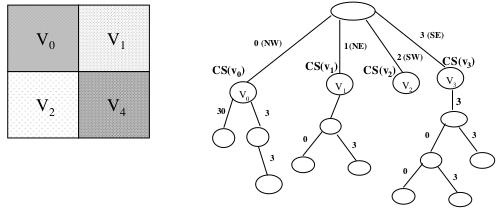
Links
Abstract
Packet classification is the problem of matching each incoming packet at a router against a database of filters, which specify forwarding rules for the packets. The filters are a powerful and uniform way to implement new network services such as firewalls, Network Address Translation (NAT), Virtual Private Networks (VPN), and per-flow or class-based Quality of Service (QOS) guarantees. While several schemes have been proposed recently that can perform packet classification at high speeds, none of them achieves fast worst-case time for adding or deleting filters from the database. In this paper, we present a new scheme, based on space decomposition, whose search time is comparable to the best existing schemes, but which also offers fast worst-case filter update time. The three key ideas in this algorithm are as follows: (1) innovative data-structure based on quadtrees for a hierarchical representation of the recursively decomposed search space, (2) fractional cascading and precomputation to improve packet classification time, and (3) prefix partitioning to improve update time. Depending on the actual requirements of the system this algorithm is deployed in, a single parameter can be used to tradeoff search time for update time. Also, this algorithm is amenable to fast software and hardware implementation.
BibTeX (Download)
@inproceedings{Buddhikot1999Space,
title = {Space Decomposition Techniques for Fast Layer-4 Switching},
author = {Milind M. Buddhikot and Subhash Suri and Marcel Waldvogel},
editor = {Joseph D. Touch and James P. G. Sterbenz},
url = {https://netfuture.ch/wp-content/uploads/1999/buddhikot99space.pdf},
isbn = {0-7923-8690-6},
year = {1999},
date = {1999-01-01},
urldate = {1000-01-01},
booktitle = {Protocols for High Speed Networks IV (Proceedings of PfHSN '99)},
pages = {25-41},
publisher = {Kluwer Academic Publishers},
address = {Salem, MA, USA},
abstract = { Packet classification is the problem of matching each incoming packet at a router against a database of filters, which specify forwarding rules for the packets. The filters are a powerful and uniform way to implement new network services such as firewalls, Network Address Translation (NAT), Virtual Private Networks (VPN), and per-flow or class-based Quality of Service (QOS) guarantees. While several schemes have been proposed recently that can perform packet classification at high speeds, none of them achieves fast worst-case time for adding or deleting filters from the database. In this paper, we present a new scheme, based on space decomposition, whose search time is comparable to the best existing schemes, but which also offers fast worst-case filter update time. The three key ideas in this algorithm are as follows: (1) innovative data-structure based on quadtrees for a hierarchical representation of the recursively decomposed search space, (2) fractional cascading and precomputation to improve packet classification time, and (3) prefix partitioning to improve update time. Depending on the actual requirements of the system this algorithm is deployed in, a single parameter can be used to tradeoff search time for update time. Also, this algorithm is amenable to fast software and hardware implementation.},
keywords = {Fast Routers, Quality of Service, Traffic Engineering},
pubstate = {published},
tppubtype = {inproceedings}
}



